Transition towards Renewable Energy Production? Potential in Smallholder Agricultural Systems in West Bengal, India
Abstract
:1. Introduction
2. Materials and Methods
2.1. Case Study Area: Geographic, Agro-Ecological, and Socio-Demographic Characteristics
2.1.1. Ghoragachha
2.1.2. Baikunthapur
2.2. Integrated Renewable Energy Potential Assessment (IREPA)
- Step 1: Contact with Research Area and Preliminary Data Assessment
- Step 2: Theoretical Renewable Energy Potential (ThREP) Assessment
- Step 3: Household and Community Assessment
- Human Capital: education level, jobs and sources of income, other skills, work distribution, openness to innovation;
- Social Capital: household members, age, decision making, water/sanitation, health, food sources and preparation, gender roles;
- Institutional: social assistance, agriculture, and energy subsidies;
- Natural Capital: environmental concerns, access to natural resources, details of the agricultural system including crops, animals, and inputs;
- Physical Capital: land ownership, waste disposal, energy supply and use patterns, knowledge of RE.
- Step 4a: Geographical Renewable Energy Potential (GREP)
- Step 4b: Technical Renewable Energy Potential (TREP)
- Step 5: RET Pre-selection and Energy System Design
- Step 6: Energy system impact assessment
- Step 7: Participatory decision-making process
3. Results
3.1. Locally Relevant Factors for RET Selection
3.1.1. Environmental Conservation
3.1.2. Land Requirement for RET Installation
3.1.3. Energy Security and Reliability
3.1.4. Reduced Expenditure on Energy Sources
3.1.5. Government Support of RET
3.1.6. Investment Costs of RET
3.1.7. Education and Development of New Skills
3.1.8. Ease of Daily Activities
3.2. Renewable Energy Potential: Solar, Wind, Hydro, Geothermal, Biomass
3.2.1. Solar Energy
3.2.2. Wind Energy
3.2.3. Hydroenergy
3.2.4. Geothermal Energy
3.2.5. Energy from Biomass
3.3. Renewable Energy Technology Pre-Selection and Planning
3.3.1. Solar-PV Systems
3.3.2. Household Biodigesters
3.3.3. Integrated Food and Energy Systems
3.4. Impact Assessment and Technology Selection
4. Discussion
4.1. Selection Factors—Whose Perspective Counts
4.2. How can the Transition towards Modern and Clean Energy in Smallholder Farming Systems in West Bengal be Promoted?
5. Conclusions
Acknowledgments
Author Contributions
Conflicts of Interest
Abbreviations
| aAHP | adapted Analytical Hierarchy Process; |
| BCKV | Bidhan Chandra Krishi Vishwavidyalaya; |
| CFL | compact fluorescent lamps; |
| GREP | Geographical renewable energy potential |
| GW | Giga Watt; INR - Indian Rupee |
| IREPA | Integrated Renewable Energy Potential Assessment |
| JNNSMP | Jawaharlal Nehru National Solar Mission Programme |
| LPG | Liquefied Petroleum Gas |
| MCDA | Multi-criteria decision analysis |
| MWh | Mega Watt hours |
| NBMMP | National Biogas and Manure Management Programme |
| NPP | Net primary productivity |
| O&M | Operation & maintenance |
| PJ | Peta Joule |
| PV | Photovoltaic |
| PTP | Partnership |
| RE | Renewable energy |
| REP | Renewable energy potential |
| RET | Renewable energy technology |
| RR | Renewable resource |
| SMART | Simple Multi-Attribute Rating Technique |
| ThREP | Theoretical renewable energy potential |
| TREP | Technical renewable energy potential |
| RPR | Residue: Product Ratio |
| WBREDA | West Bengal Renewable Energy Development Agency |
| Wp | Watt peak |
References
- International Energy Agency (IEA). Energy Matters: How COP21 Can Shift the Energy Sector onto a Low-Carbon Path That Supports Economic Growth and Energy Access. Available online: https://www.iea.org/media/presentations/Energy_Matters_brochure.PDF (accessed on 18 January 2016).
- De Vries, B.J.M.; van Vuuren, D.P.; Hoogwijk, M.M. Renewable energy sources: Their global potential for the first-half of the 21st century at a global level: An integrated approach. Energy Policy 2007, 35, 2590–2610. [Google Scholar] [CrossRef]
- International Assessment of Agricultural Knowledge, Science, and Technology for Development (Project). Synthesis Report: A Synthesis of the Global and Sub-Global IAASTD Reports; Agriculture at a Crossroads; McIntyre, B.D., Ed.; Island Press: Washington, DC, USA, 2009; ISBN 978-1-59726-550-8. [Google Scholar]
- Kaygusuz, K. Energy for sustainable development: A case of developing countries. Renew. Sustain. Energy Rev. 2012, 16, 1116–1126. [Google Scholar] [CrossRef]
- Dev, S.M. Small Farmers in India: Challenges and Opportunities; Indira Gandhi Institute of Development Research (IGIDR): Mumbai, India, 2012. [Google Scholar]
- International Energy Agency (IEA). India Energy Outlook: World Energy Outlook Special Report; Organisation for Economic Co-Operation (OECD): Paris, France, 2015. [Google Scholar]
- Kumar, A.; Kumar, K.; Kaushik, N.; Sharma, S.; Mishra, S. Renewable energy in India: Current status and future potentials. Renew. Sustain. Energy Rev. 2010, 14, 2434–2442. [Google Scholar] [CrossRef]
- Jain, A.; Ray, S.; Ganesan, K.; Aklin, M.; Cheng, C.-Y.; Urpelainen, J. Access to Clean Cooking Energy and Electricity: Survey of States; Council on Energy, Environment and Water: New Dehli, India, 2015; p. 98. [Google Scholar]
- Resch, G.; Held, A.; Faber, T.; Panzer, C.; Toro, F.; Haas, R. Potentials and prospects for renewable energies at global scale. Energy Policy 2008, 36, 4048–4056. [Google Scholar] [CrossRef]
- United Nations Framework Convention on Climate Change (UNFCCC). India’s Intended Nationally Determined Contribution: Working towards Climate Justice; UNFCCC: New York, NY, USA, 2015. [Google Scholar]
- Hailu, Y.G. Measuring and monitoring energy access: Decision-support tools for policymakers in Africa. Energy Policy 2012, 47, 56–63. [Google Scholar] [CrossRef]
- Wang, J.-J.; Jing, Y.-Y.; Zhang, C.-F.; Zhao, J.-H. Review on multi-criteria decision analysis aid in sustainable energy decision-making. Renew. Sustain. Energy Rev. 2009, 13, 2263–2278. [Google Scholar] [CrossRef]
- Schäfer, M.; Kebir, N.; Neumann, K. Research needs for meeting the challenge of decentralized energy supply in developing countries. Energy Sustain. Dev. 2011, 15, 324–329. [Google Scholar] [CrossRef]
- Amigun, B.; Musango, J.K.; Brent, A.C. Community perspectives on the introduction of biodiesel production in the Eastern Cape Province of South Africa. Energy 2011, 36, 2502–2508. [Google Scholar] [CrossRef]
- Barry, M.-L.; Steyn, H.; Brent, A. Selection of renewable energy technologies for Africa: Eight case studies in Rwanda, Tanzania and Malawi. Renew. Energy 2011, 36, 2845–2852. [Google Scholar] [CrossRef]
- Alam Hossain Mondal, M.; Kamp, L.M.; Pachova, N.I. Drivers, barriers, and strategies for implementation of renewable energy technologies in rural areas in Bangladesh—An innovation system analysis. Energy Policy 2010, 38, 4626–4634. [Google Scholar] [CrossRef]
- Palit, D.; Chaurey, A. Off-grid rural electrification experiences from South Asia: Status and best practices. Energy Sustain. Dev. 2011, 15, 266–276. [Google Scholar] [CrossRef]
- García, V.G.; Bartolomé, M.M. Rural electrification systems based on renewable energy: The social dimensions of an innovative technology. Technol. Soc. 2010, 32, 303–311. [Google Scholar] [CrossRef]
- Frederiks, E.R.; Stenner, K.; Hobman, E.V. Household energy use: Applying behavioural economics to understand consumer decision-making and behaviour. Renew. Sustain. Energy Rev. 2015, 41, 1385–1394. [Google Scholar] [CrossRef]
- Winkler, B.; Lemke, S.; Ritter, J.; Lewandowski, I. Integrated assessment of renewable energy potential: Approach and application in rural South Africa. Environ. Innov. Soc. Transit. 2017, 24, 17–31. [Google Scholar] [CrossRef]
- Rajarhat PRASARI. Livelihood Zones in West Bengal—A Scenario for AWM Interventions; Prepared by Rajarhat PRASARI; In Consultation with the Food and Agriculture Organization of the United Nations; Rajarhat PRASARI: Kolkata, India, 2011. [Google Scholar]
- Nabcons. State Agriculture Plan for West Bengal; NABARD Consultancy Services PVT Ltd. on Behalf of Agriculture Department, Government of West Bengal: Kolkata, India, 2009.
- Bhattacharyya, R. Crop diversification: A search for an alternative income of the farmers in the State of West Bengal in India. In Proceedings of the International Conference on Applied Economics, Kastoria, Greece, 15–17 May 2008; pp. 83–94. [Google Scholar]
- West Bengal AgriMarketing Board. Rainfall by District and Month in West Bengal (10yrs. average). Available online: http://www.wbagrimarketingboard.gov.in/Area/Rain.html (accessed on 25 January 2015).
- Directorate of Micro, Small and Medium Enterprises. Chakdaha Block; Government of West Bengal: West Bengal, India, 2015.
- Directorate of Micro, Small and Medium Enterprises. Amdanga Block; Government of West Bengal: West Bengal, India, 2015.
- Hoogwijk, M. On the Global and Regional Potential of Renewable Energy Sources; Faculteit Scheikunde, Universiteit Utrecht: Utrecht, The Netherlands, 2004. [Google Scholar]
- NASA. Surface Meteorology and Solar Energy. Available online: https://eosweb.larc.nasa.gov/sse/RETScreen/ (accessed on 22 January 2015).
- National Institute of Wind Energy. Numerical Wind Atlas File (.lib) for Sale—West Bengal. Available online: http://niwe.res.in/department_wra_nwa.php (accessed on 6 February 2015).
- Parua, P.K. The Ganga: Water Use in the Indian Subcontinent; Water Science and Technology Library; Springer: Dordrecht, The Netherlands; New York, NY, USA, 2010; ISBN 978-90-481-3102-0. [Google Scholar]
- NASA. Earth Observations NASA Earth Observations (NEO). Available online: http://neo.sci.gsfc.nasa.gov/view.php?datasetId=MOD17A2_M_PSN (accessed on 22 January 2015).
- Chandrasekharam, D.; Chandrasekha, V. Geothermal energy resources of India: Country update. In Proceedings of the World Geothermal Congress, Melbourne, Australia, 19–25 April 2015; International Geothermal Association: Bochum, Germany, 2015. [Google Scholar]
- Chambers, R. The Origins and Practice of Participatory Rural Appraisal. World Dev. 1994, 22, 953–969. [Google Scholar] [CrossRef]
- Scoones, I. Sustainable Rural Livelihoods: A Framework for Analysis; IDS Working Paper; Institute of Development Studies: Brighton, UK, 1998; ISBN 978-1-85864-224-6. [Google Scholar]
- Creswell, J.W. Research Design: Qualitative, Quantitative, and Mixed Methods Approache, 3rd ed.; Sage Publications: Thousand Oaks, CA, USA, 2009; ISBN 978-1-4129-6556-9. [Google Scholar]
- Food and Agriculture Organization of the United Nations (FAO). FAOSTAT. Available online: http://www.fao.org/faostat/en/#data (accessed on 22 January 2015).
- Saaty, T.L. How to make a decision: The analytic hierarchy process. Eur. J. Oper. Res. 1990, 48, 9–26. [Google Scholar] [CrossRef]
- Chen, Y.; Okudan, G.E.; Riley, D.R. Decision support for construction method selection in concrete buildings: Prefabrication adoption and optimization. Autom. Constr. 2010, 19, 665–675. [Google Scholar] [CrossRef]
- Brugha, C.M. Structuring and Weighting Criteria in Multi Criteria Decision Making (MCDM). In Trends in Multicriteria Decision Making; Stewart, T.J., van den Honert, R.C., Eds.; Springer: Berlin/Heidelberg, Germany, 1998; Volume 465, pp. 229–242. ISBN 978-3-540-64741-6. [Google Scholar]
- Subash, N.; Sikka, A.K. Trend analysis of rainfall and temperature and its relationship over India. Theor. Appl. Climatol. 2014, 117, 449–462. [Google Scholar] [CrossRef]
- Rogers, E.M. Diffusion of Innovations, 3rd ed.; Free Press, Collier Macmillan: New York, NY, USA; London, UK, 1983; ISBN 978-0-02-926650-2. [Google Scholar]
- Ministry of Statistics and Project Implementation. Energy Statistics 2015. Available online: http://mospi.nic.in/Mospi_New/upload/Energy_stats_2015_26mar15.pdf (accessed on 7 March 2016).
- Ministry of New and Renewable Energy; Biogas Technology Development Division. National Biogas and Manure Management Programme (NBMMP). Available online: http://www.mnre.gov.in/schemes/decentralized-systems/schems-2/ (accessed on 23 January 2015).
- Ministry of New and Renewable Energy. Jawaharlal Nehru National Solar Mission. Available online: http://www.mnre.gov.in/solar-mission/jnnsm/introduction-2/ (accessed on 23 January 2015).
- The Energy and Resources Institute (TERI). Fixed-Dome Biogas Plant for Rural Households. Available online: http://www.teriin.org/technology/fxed-dome (accessed on 26 January 2016).
- Sankalpa Trust. Sankalpa White Paper: Renewable Energy Technology Center; Sankalpa Trust: Kolkata, India, 2009. [Google Scholar]
- Rajendran, K.; Aslanzadeh, S.; Taherzadeh, M.J. Household Biogas Digesters—A Review. Energies 2012, 5, 2911–2942. [Google Scholar] [CrossRef]
- Current Results. Weather in India—Sunshine Hours. Available online: http://www.currentresults.com/Weather/India/annual-sunshine.php (accessed on 17 February 2016).
- Surana Solar Ltd. PV-Panel-Datasheet/Polycrystalline. Available online: http://www.enfsolar.com/pv/panel-datasheet/Polycrystalline/17127?utm_source=ENF&utm_medium=panel_profile&utm_campaign=enquiry_company_directory&utm_content=5666 (accessed on 26 January 2016).
- Jölli, D.; Giljum, S. Unused Biomass Extraction in Agriculture, Forestry and Fishery; Sustainable Europe Research Institute (SERI): Vienna, Austria, 2005. [Google Scholar]
- Hiloidhari, M.; Das, D.; Baruah, D.C. Bioenergy potential from crop residue biomass in India. Renew. Sustain. Energy Rev. 2014, 32, 504–512. [Google Scholar] [CrossRef]
- Babaee, A.; Shayegan, J. Effect of organic loading rates (OLR) on production of methane from anaerobic digestion of vegetables waste. In Proceedings of the World Renewable Energy Congress, Linköping, Sweden, 8–13 May 2011; pp. 411–417. [Google Scholar]
- Chen, W.-C.; Chen, W.-C.; Geng, D.-S. The Strategy and Bioenergy Potential for Kitchen Waste Recycling in Taiwan. J. Environ. Eng. Manag. 2008, 18, 281–287. [Google Scholar]
- Dhanalakshmi, S.; Srinivasan, S.V.; Kayalvizhi, R.; Bhuvaneswari, R. Studies on Conversion of Carbohydrate content in the Mixture of Vegetable Wastes into Biogas in a Single Stage Anaerobic Reactor. Res. J. Chem. Sci. 2012, 2, 66–71. [Google Scholar]
- Patil, V.S.; Deshmukh, H.V. Biomethanation Potential Study of Individual and Combined Vegetable Market Wastes. Int. Res. J. Environ. Sci. 2015, 4, 75–80. [Google Scholar]
- Capacity Development for the Clean Development Mechanism (CD4CDM). Mini-Biogas Plants for Households; Working Paper Series: Working Paper No. 8—PoA CDM Manual; Capacity Development for the Clean Development Mechanism (CD4CDM): Roskilde, Denmark, 2009. [Google Scholar]
- Pourmovahed, A.; Opperman, T.; Lemke, B. Performance and efficiency of a biogas CHP system utilizing a stirling engine. Renew. Energy Power Qual. J. 2011, 202–207. [Google Scholar] [CrossRef]
- Gogoi, J.K.; Goswami, H.; Borah, K.C. Problems of International Border Areas in Manipur: Implications for the Thirteenth Finance Commission. SSRN Electron. J. 2009. [Google Scholar] [CrossRef]
- AFPRO. Deenbandhu Model 2000 Biogas Plant. Available online: http://www.sswm.info/sites/default/files/reference_attachments/AFPRO%202005%20Deenbandhu%20Model%202000%20Biogas%20Plant.pdf (accessed on 10 March 2016).
- Luthra, S.; Kumar, S.; Garg, D.; Haleem, A. Barriers to renewable/sustainable energy technologies adoption: Indian perspective. Renew. Sustain. Energy Rev. 2015, 41, 762–776. [Google Scholar] [CrossRef]
- Khandker, S.R.; Barnes, D.F.; Samad, H.A. Are the energy poor also income poor? Evidence from India. Energy Policy 2012, 47, 1–12. [Google Scholar] [CrossRef]
- Arora, P.R. World’s Highest Off-grid Solar PV Potential in India—Search and Penetrate. Int. J. Sci. Res. Publ. 2013, 3, 1–7. [Google Scholar]
- Jiang, X.; Sommer, S.G.; Christensen, K.V. A review of the biogas industry in China. Energy Policy 2011, 39, 6073–6081. [Google Scholar] [CrossRef]
- Roychowdhury, R.; Abdel Gawwad, M.R.; Banerjee, U.; Bishnu, S.; Tah, J. Status, Trends and Prospects of Organic Farming in India: A Review. J. Plant Biol. Res. 2013, 2, 38–48. [Google Scholar]
- Raha, D.; Mahanta, P.; Clarke, M.L. The implementation of decentralised biogas plants in Assam, NE India: The impact and effectiveness of the National Biogas and Manure Management Programme. Energy Policy 2014, 68, 80–91. [Google Scholar] [CrossRef]
- International Renewable Energy Agency (IRENA). The Power to Change: Solar and Wind Cost Reduction Potential to 2025; IRENAs Innovation and Technology Centre (IITC): Bonn, Germany, 2016; p. 112. [Google Scholar]
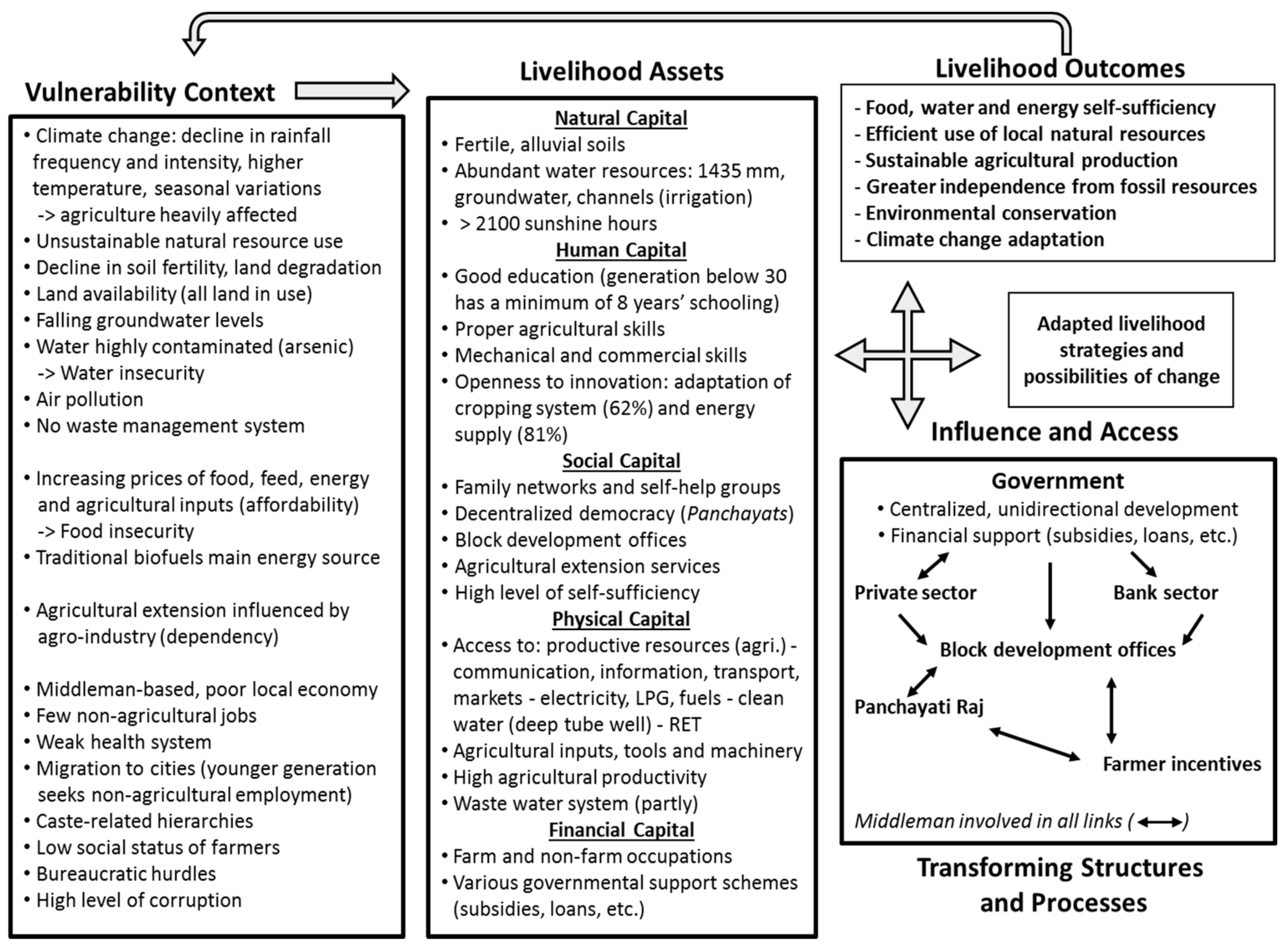
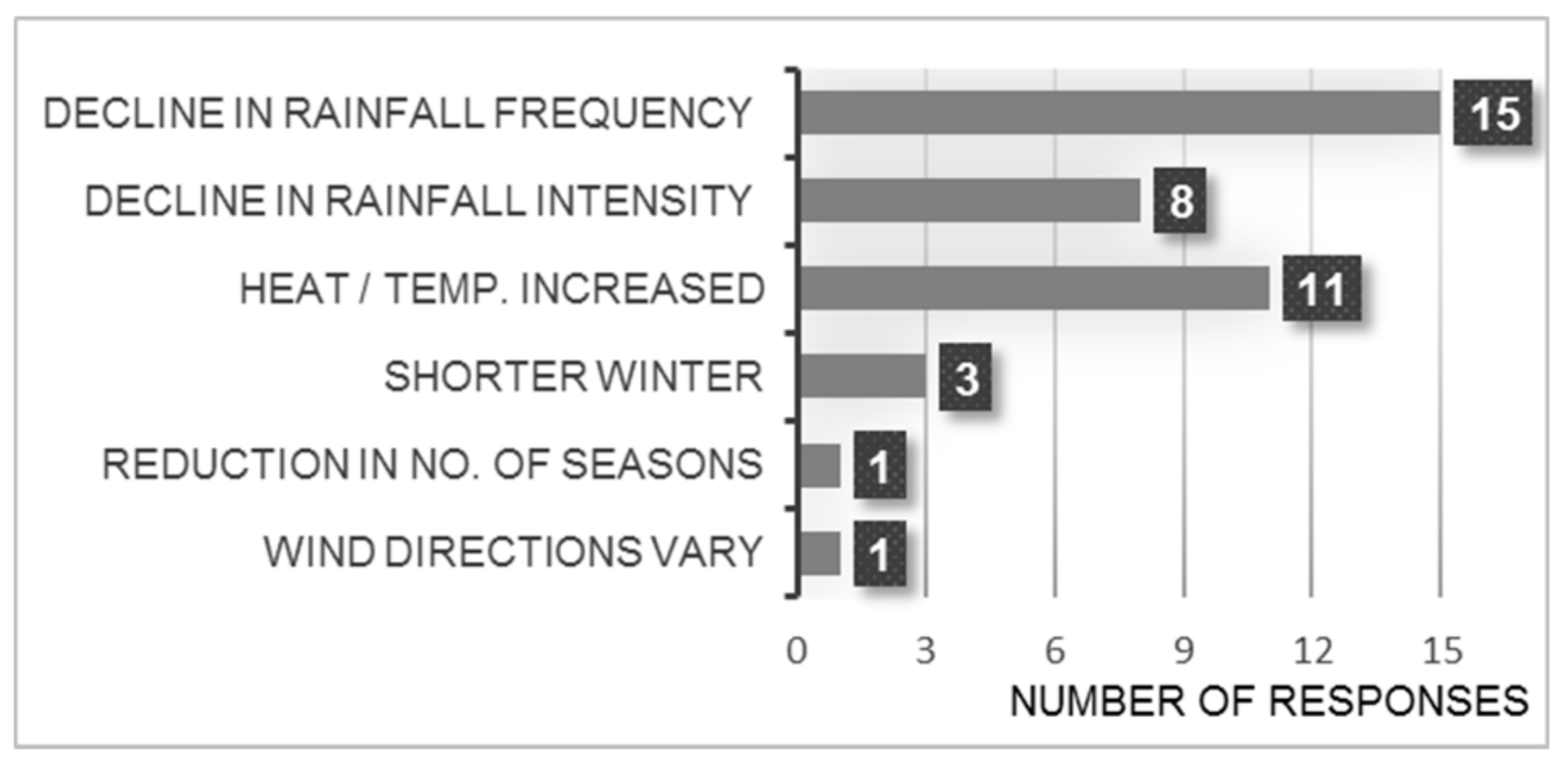
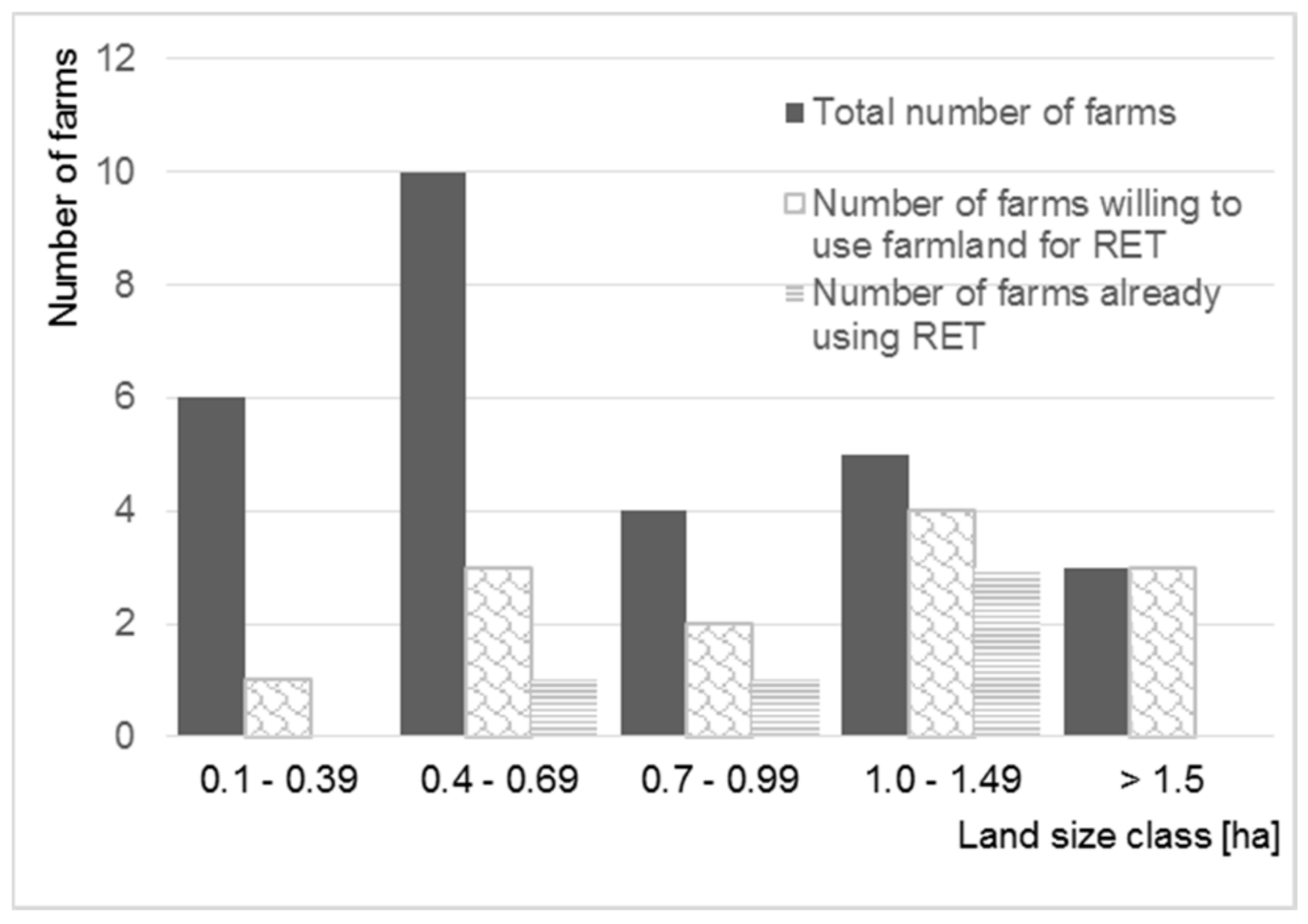
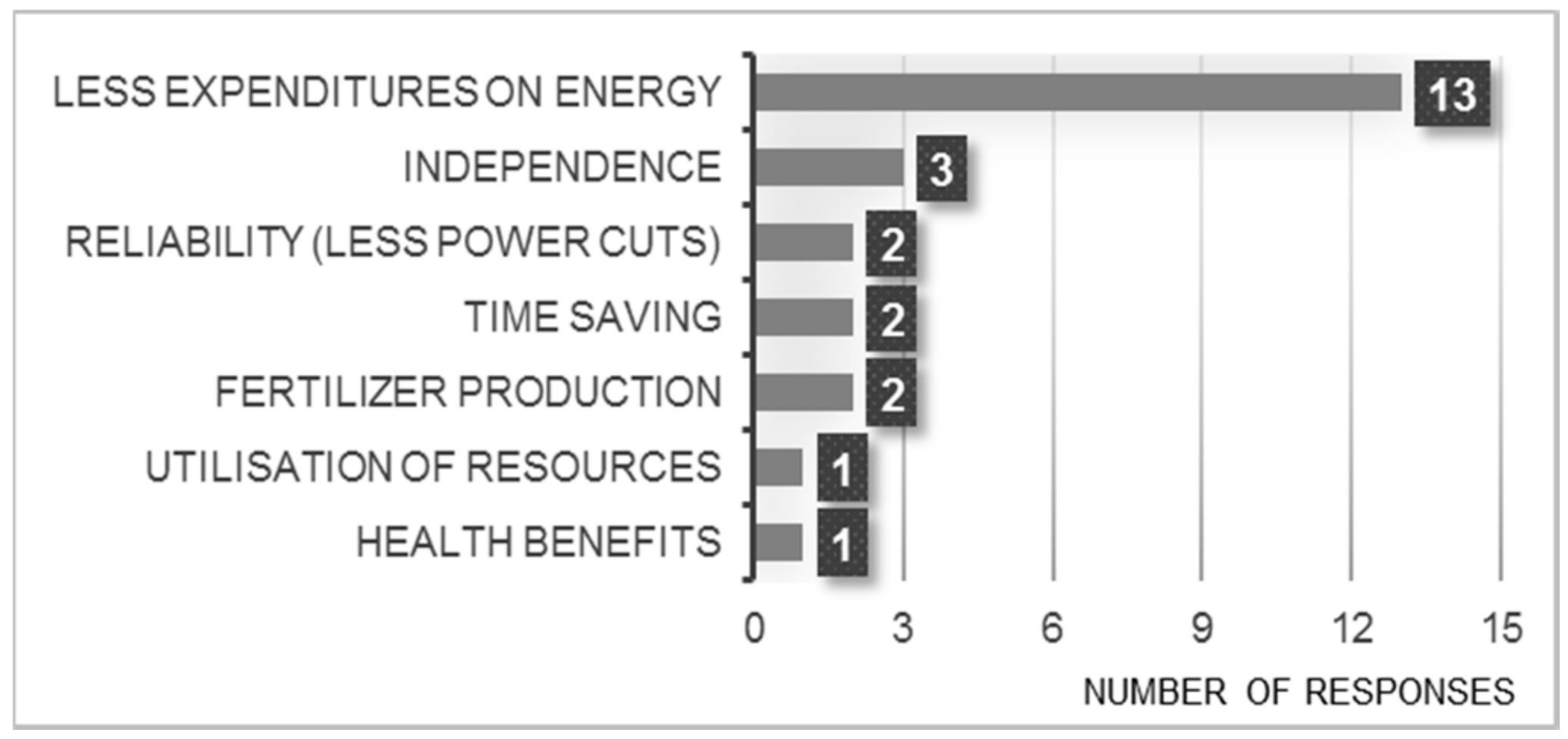
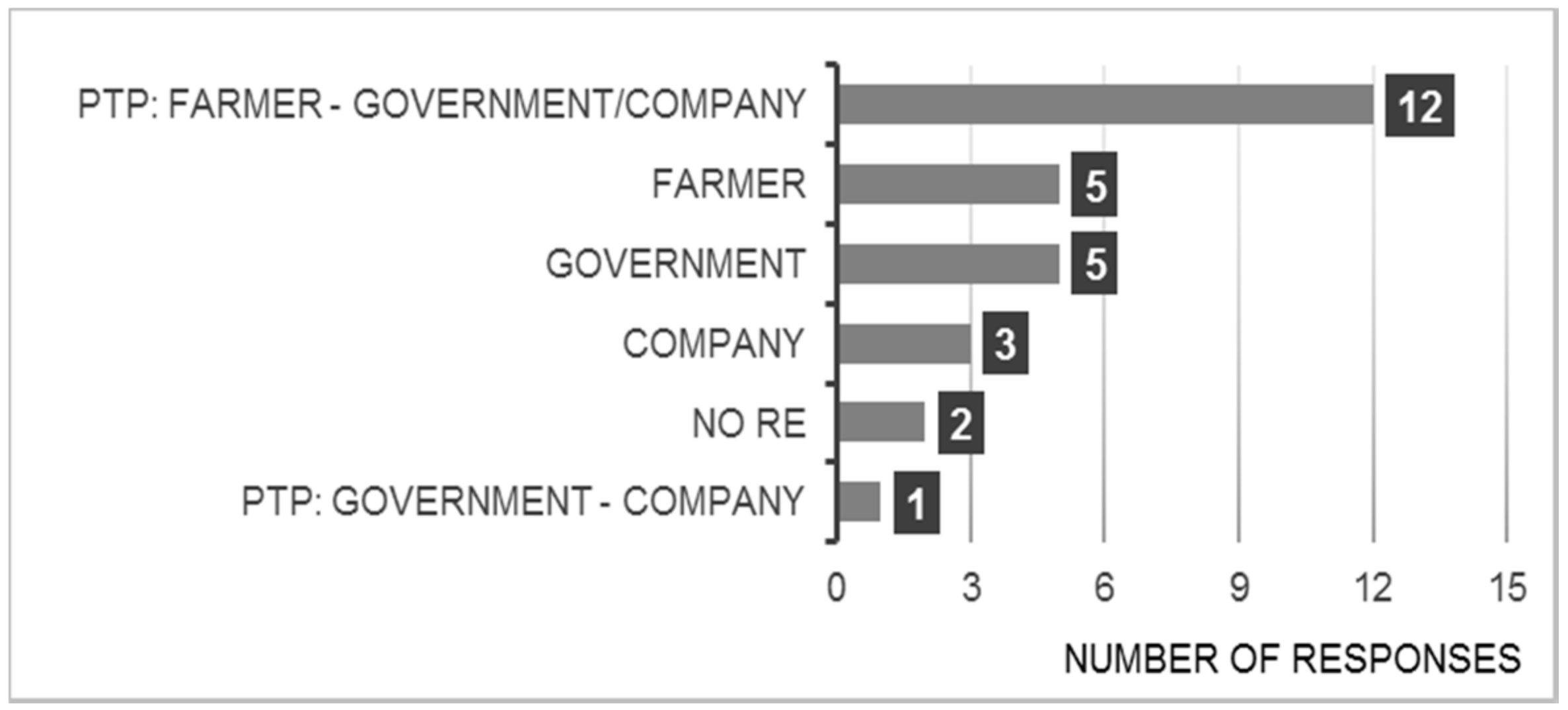
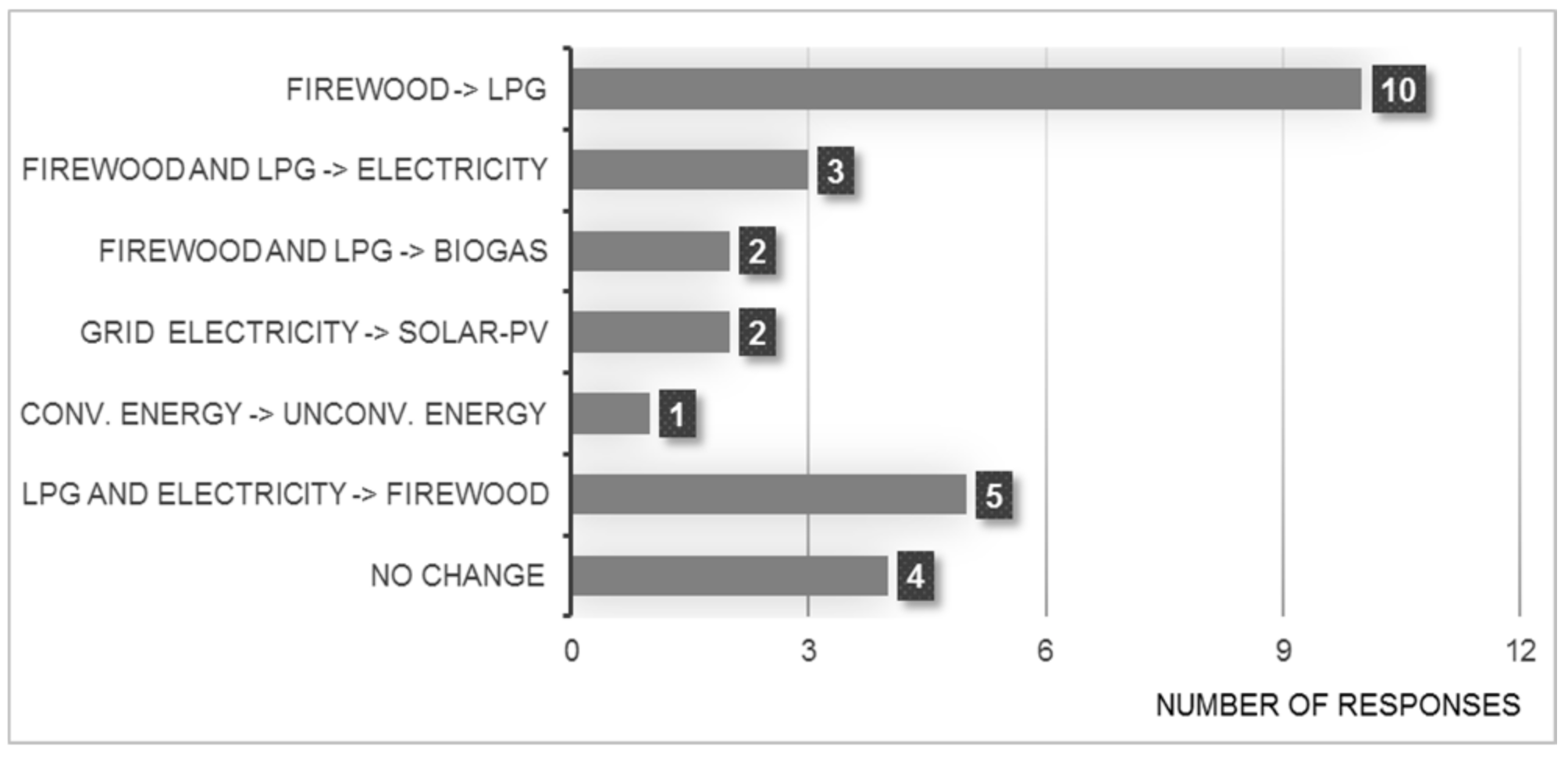
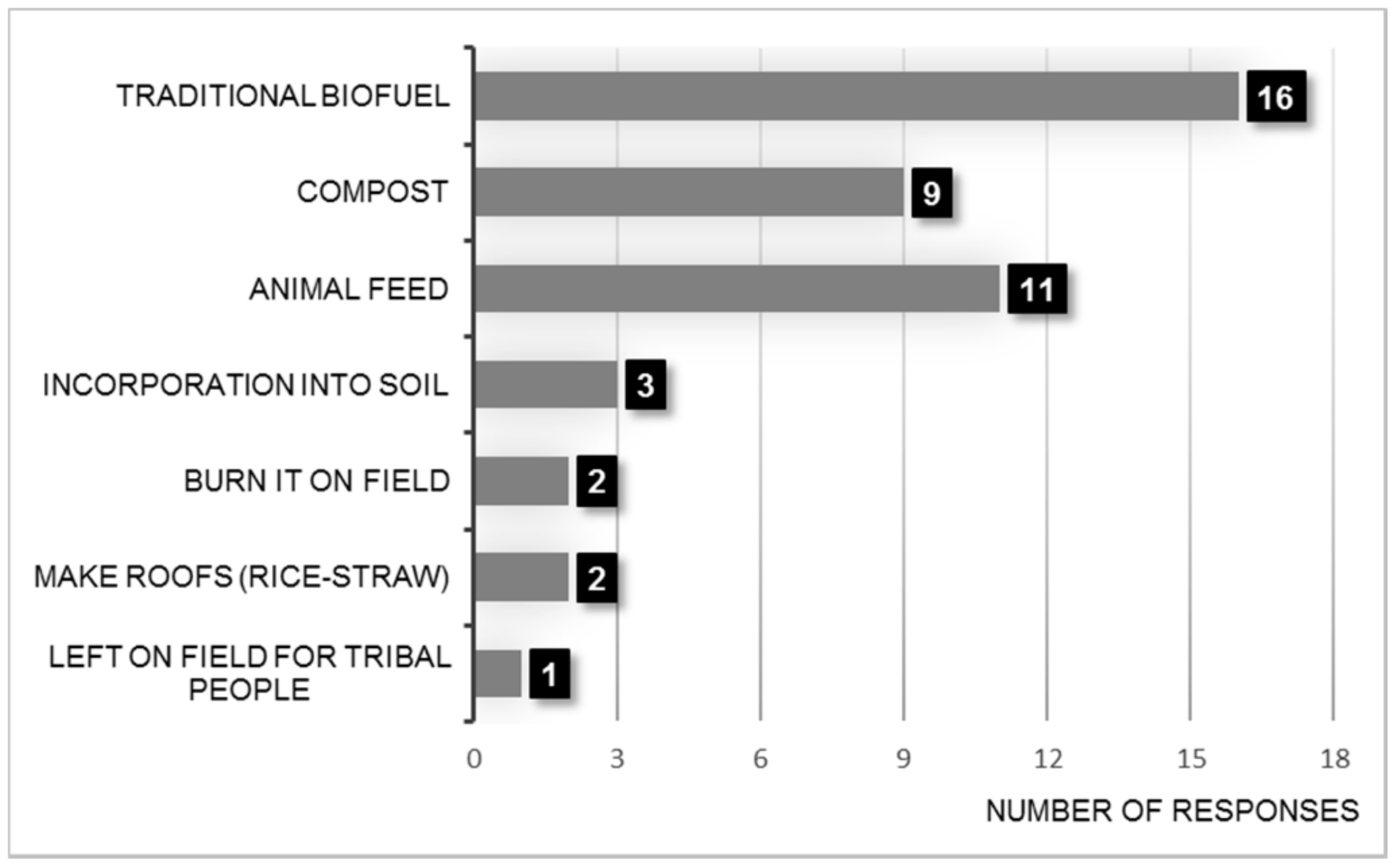

| Renewable Resource | Data Sources |
|---|---|
| Solar | [28] |
| Wind | [28,29] |
| Hydro | [30] |
| Biomass | [31], Own analysis, see Section 3.2.5 |
| Geothermal | [32] |
| PLA Method | Number of Respondents | Description |
|---|---|---|
| Transect walk at Ghoragachha and Baikunthapur | Exploration of village structure; drawing of village map; informal interviews | |
| Participant observation | Sowing, harvest, irrigation, fertilizer and pesticide application, rice processing, cooking (with traditional biofuels, LPG, biogas), dung-cake making | |
| Open-ended, semi-structured household interviews | n = 29 | Ghoragachha n = 21 (18 male, 3 female); Baikunthapur n = 8 (all male) |
| Visits of households using solar-PV and/or biodigesters | n = 10 | Ghoragachha and Baikunthapur |
| Key-informant interviews | n = 8 | Head of the Dept. Agricultural Extension, BCKV Professor at the Dept. Agricultural Extension, BCKV Director of Lake Hall Campus, BCKV Block Development Officer (BDO), Chakdaha Block Agricultural Development Officer (ADO), Chakadaha Block Two Ph.D. students, Dept. Agricultural Extension, BCKV M.Sc. Student, Dept. Agricultural Extension, BCKV |
| Participatory construction of an Integrated Food and Energy System for demonstration | At a smallholder farming household, Ghoragachha (See Section 3.3.3) | |
| Focus-group | n = 8 | Introduction of RET selection factors and pre-selected RETApplication of AHP and SMART with seven previously interviewed farmers from Ghoragachhafive key informants (BDO, ADO, two Ph.D. students, M.Sc. student) |
| Review of secondary sources | [8,17,18,19,20,21,22,32,33,34] |
| Energy Source Used for Cooking | Percentrage of Farming Households |
|---|---|
| Traditional biomass and LPG | 52 |
| Traditional biomass and kerosene | 10 |
| Traditional biomass only | 24 |
| LPG only | 3 |
| Biogas and traditional biomass | 3 |
| Biogas and LPG | 7 |
| Household Demand | Household Expenditures | |||
|---|---|---|---|---|
| Ø | Ø | min | max | |
| Electricity | [kWh month−1] | [INR month−1] | ||
| 101 | 495 | 83 | 2500 | |
| LPG | [kg month−1] | [INR month−1] | ||
| 10.6 | 314 * | 83 * | 420 * | |
| Traditional biofuels | 366 | 1281 ** | 140 ** | 3202 ** |
| Solar | Wind | Hydro | Geothermal | Biomass | ||||||
|---|---|---|---|---|---|---|---|---|---|---|
| ᴓ power density | (W m−2) | (W m−2) | (MW) | (W m−2) | (W m−2 a−1) | |||||
| 199.70 | 4.98 | 391.70 | 0.20 | 0.43 | ||||||
| Min/Max | 170–257 | 1.3–11.7 | n.a. | n.a. | 0.41–0.45 | |||||
| (PJ a−1) | (PJ a−1) | (PJ a−1) | (PJ a−1) | (PJ a−1) | ||||||
| Gh. | Ba. | Gh. | Ba. | Gh. | Ba. | Gh. | Ba. | Gh. | Ba. | |
| ThREP | 17.315 | 4.299 | 0.011 * | 12.353 | 0.778 ** | 0.156 # | 0.039 # | |||
| GREP | 17.162 | 4.280 | <threshold | not accessible | not accessible | 0.004 ## | 0.008 ## | |||
| TREP | 0.015 | 0.003 | <threshold | not accessible | not accessible | 0.003 ## | 0.005 ## | |||
| Source | [28] | [28,29] | [30] | [32] | # [31]; ## This study | |||||
| Feedstock | Average Crop Yield | RPR * | Biogas Yield ** | |
|---|---|---|---|---|
| Ghoragachha | Baikunthapur | |||
| (t ha−1) | (x: 1) | (m3 farm−1 a−1) | (m3 farm−1 a−1) | |
| Rice straw (Kharif) | 4.7 | 1.5 | 595 | 428 |
| Vegetable residues (Rabi) | 26.5 | 0.5 | 591 | 662 |
| Vegetable residues (Zaid) | 7.2 | 0.5 | 138 | 154 |
| Amount available | ||||
| Ghoragachha | Baikunthapur | |||
| kg farm−1 a−1 | kg farm−1 a−1 | (m3 farm−1 a−1) | (m3 farm−1 a−1) | |
| Organic waste ^ | 449 | 70 | 29 | 5 |
| Human excreta # | 456 | 531 | 30 | 35 |
| Animal manure ## | 2034 | 9636 | 48 | 226 |
| Total biogas volume (m³ farm−1 a−1) | 1431 | 1510 | ||
| Geographic bioenergy potentialLHV (PJ village−1 a−1) | 0.004 | 0.008 | ||
| Technical bioenergy potentialTh. Eff. (PJ village−1 a−1) | 0.003 | 0.005 | ||
| Electricity Demand | low | Ø | high |
|---|---|---|---|
| PV system capacity | 500 Wp | 1000 Wp | 1500 Wp |
| Panel area [m2] | 4 | 8 | 12 |
| Solar PV system parts | Costs [INR] | Costs [INR] | Costs [INR] |
| Panels | 28,494 | 57,000 | 85,500 |
| Battery | 20,700 | 37,862 | 52,818 |
| Inverter | 4395 | 5637 | 6667 |
| Charge Controller | 2500 | 2500 | 2500 |
| Roof installation structure, cables, etc. | 7000 | 9000 | 10,000 |
| Installation | 8000 | 8000 | 8000 |
| Total investment costs [INR] | 71,089 | 119,999 | 165,485 |
| JNNSMP subsidy: 30% of total costs [INR] | 21,327 | 36,000 | 49,646 |
| Tax savings—accelerated depreciation [INR] | 13,933 | 23,520 | 32,435 |
| Net investment costs [INR] | 35,829 | 60,479 | 83,404 |
| 507 € | 856 € | 1180 € | |
| Monthly savings [INR] | 250 | 500 | 750 |
| Financial amortisation [years] | 11.9 | 10.1 | 9.3 |
| Rank | Selection Criteria | Averaged Rating | STD |
|---|---|---|---|
| 1 | Ease of daily activities | 0.1669 | 0.1817 |
| 2 | Government support | 0.1531 | 0.0944 |
| 3 | Land/area requirements | 0.1504 | 0.1282 |
| 4 | Environmental conservation | 0.1358 | 0.1052 |
| 5 | Investment costs | 0.1250 | 0.2217 |
| 6 | Reduced expenditures on energy | 0.1107 | 0.0856 |
| 7 | Energy security and realibility | 0.0959 | 0.1200 |
| 8 | Education and development of new skills | 0.0563 | 0.0532 |
| Rank | RE Systems | Averaged Rating | STD |
|---|---|---|---|
| 1 | Solar-PV home system | 0.2934 | 0.0726 |
| 2 | Solar-PV irrigation system | 0.2926 | 0.1266 |
| 3 | Integrated food and energy system | 0.2404 | 0.0887 |
| 4 | Biodigester | 0.1953 | 0.1422 |
| Rank | Selection Criteria | Averaged Rating | STD |
|---|---|---|---|
| 1 | Investment costs | 0.1649 | 0.0343 |
| 2 | Government support | 0.1586 | 0.0262 |
| 3 | Reduced expenditures on energy | 0.1242 | 0.0234 |
| 4 | Land/area requirements | 0.1225 | 0.0343 |
| 5 | Energy security and realibility | 0.1132 | 0.0186 |
| 6 | Ease of daily activities | 0.1124 | 0.0130 |
| 7 | Education and development of new skills | 0.1048 | 0.0207 |
| 8 | Environmental conservation | 0.0994 | 0.0156 |
| Rank | RE Systems | Averaged Rating | STD |
|---|---|---|---|
| 1 | Solar-PV home system | 0.7890 | 0.1014 |
| 2 | Integrated food and energy system | 0.7807 | 0.0611 |
| 3 | Biodigester | 0.7712 | 0.0780 |
| 4 | Solar-PV irrigation system | 0.7133 | 0.1518 |
© 2018 by the authors. Licensee MDPI, Basel, Switzerland. This article is an open access article distributed under the terms and conditions of the Creative Commons Attribution (CC BY) license (http://creativecommons.org/licenses/by/4.0/).
Share and Cite
Winkler, B.; Lewandowski, I.; Voss, A.; Lemke, S. Transition towards Renewable Energy Production? Potential in Smallholder Agricultural Systems in West Bengal, India. Sustainability 2018, 10, 801. https://doi.org/10.3390/su10030801
Winkler B, Lewandowski I, Voss A, Lemke S. Transition towards Renewable Energy Production? Potential in Smallholder Agricultural Systems in West Bengal, India. Sustainability. 2018; 10(3):801. https://doi.org/10.3390/su10030801
Chicago/Turabian StyleWinkler, Bastian, Iris Lewandowski, Angelika Voss, and Stefanie Lemke. 2018. "Transition towards Renewable Energy Production? Potential in Smallholder Agricultural Systems in West Bengal, India" Sustainability 10, no. 3: 801. https://doi.org/10.3390/su10030801
APA StyleWinkler, B., Lewandowski, I., Voss, A., & Lemke, S. (2018). Transition towards Renewable Energy Production? Potential in Smallholder Agricultural Systems in West Bengal, India. Sustainability, 10(3), 801. https://doi.org/10.3390/su10030801







